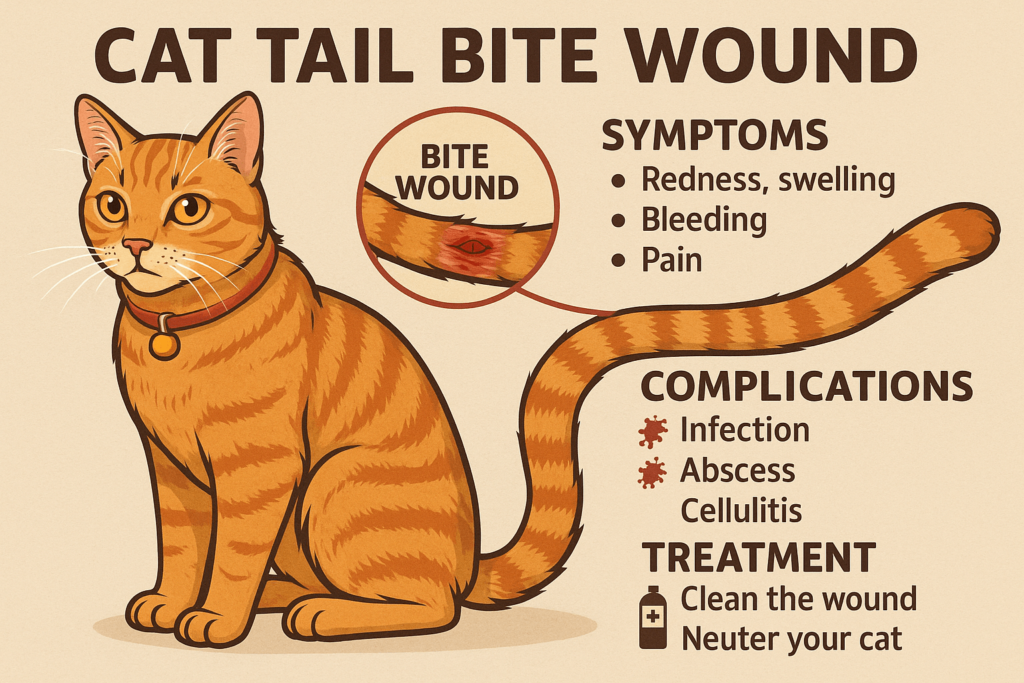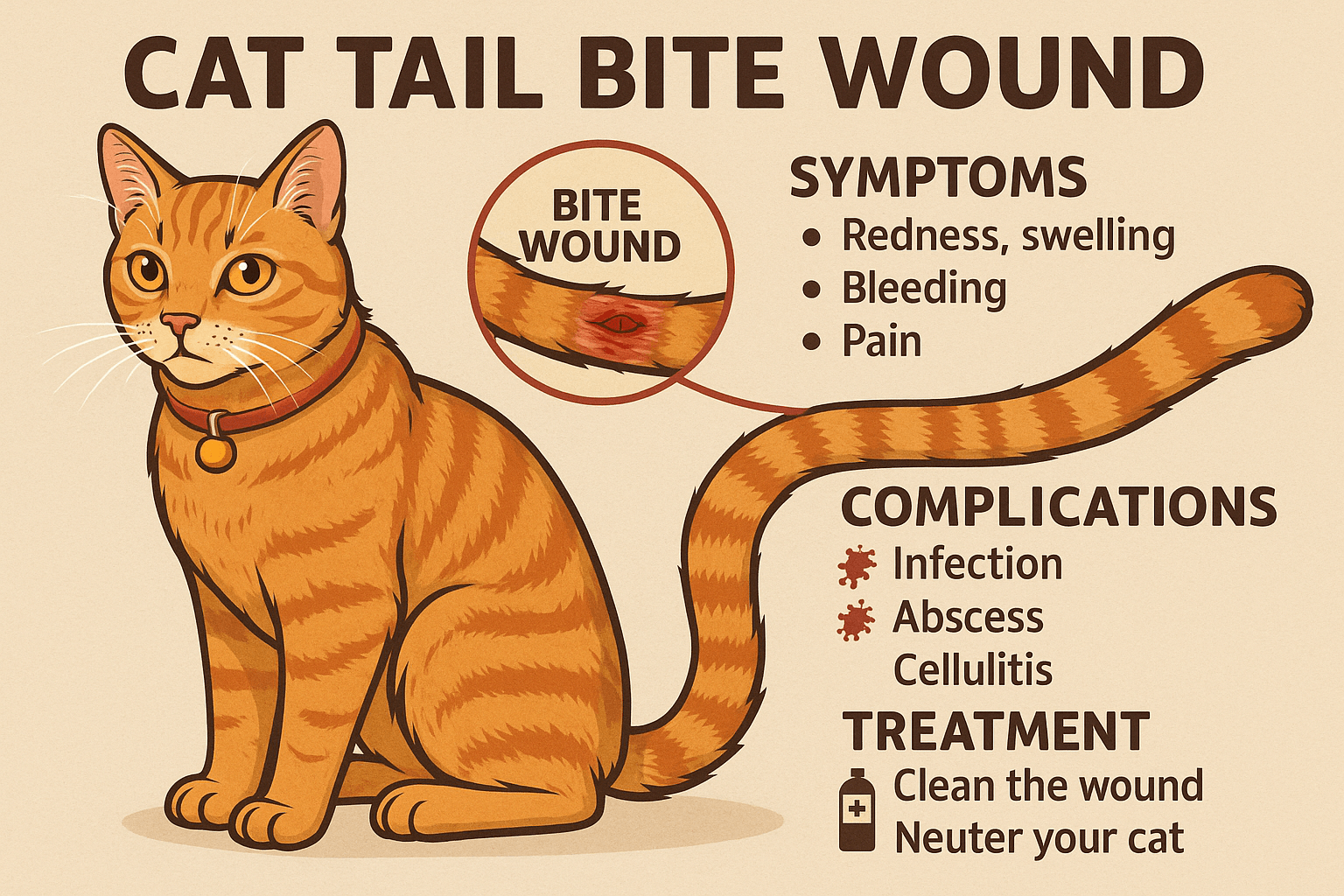Understanding Cat Tail Bite Wounds: Causes, Treatment, and Prevention
Cats are naturally playful and curious creatures, but their interactions can sometimes lead to injuries, including bite wounds on their tails. A cat tail bite wound may seem minor at first glance, but it can escalate into a serious issue if left untreated. Whether caused by territorial disputes, rough play, or aggressive encounters, these wounds require prompt attention to prevent infections and complications. In this blog post, we’ll explore the causes of tail bite wounds, how to treat them effectively, and steps you can take to protect your feline friend from harm. Let’s dive in and ensure your cat stays happy, healthy, and injury-free.
Expert Insight: The Importance of Preventing Cat Tail Injuries
Because of these reasons, it’s important for pet owners to keep their cats’ tails free from injuries and infections. Thankfully, says Heather DiGiacomo, veterinarian and owner of Newtown Square Veterinary Hospital in Newtown Square, Pennsylvania, tail injuries are relatively uncommon in cats. “Outdoor cats are more at risk,” she says, “so keeping cats indoors can dramatically reduce the incidence of tail injuries.”
Common Causes of Cat Tail Bite Wounds
A cat tail bite wound can occur for several reasons, often tied to a cat’s behavior or environment. Understanding these causes is the first step toward prevention.
Territorial Aggression:
Cats are territorial animals, and conflicts over space can result in biting or attacking each other, often targeting vulnerable areas like the tail.Rough Play Between Cats:
Kittens and adult cats sometimes play too aggressively, leading to accidental bites or scratches on the tail.Redirected Aggression:
If a cat becomes agitated by an external stimulus (like another animal outside), they may redirect their frustration onto their housemate’s tail.Self-Biting Due to Skin Issues:
Cats suffering from allergies, fleas, or other skin irritations may bite their own tails in an attempt to relieve discomfort.Predatory Behavior:
Some cats exhibit hunting instincts, chasing and biting moving objects—including their own or another cat’s tail.
By identifying the root cause of the cat tail bite wound, you can take targeted steps to address the issue and prevent future incidents.

Signs Your Cat Has a Tail Bite Wound
Recognizing the symptoms of a cat tail bite wound early can make all the difference in ensuring proper care. Keep an eye out for these telltale signs that your cat may be injured.
Visible Redness or Swelling:
Check your cat’s tail for any red, swollen, or inflamed areas that indicate trauma or infection.Excessive Licking or Chewing:
Cats often lick their wounds to clean them, but excessive grooming of the tail area could signal irritation or pain.Limping or Avoidance of Tail Movement:
If your cat avoids moving their tail or seems to limp when walking, it could mean they’re experiencing discomfort.Bleeding or Open Sores:
Any sign of blood, scabs, or open wounds on the tail should be addressed immediately to prevent further complications.Changes in Behavior:
Increased aggression, hiding, or reluctance to interact may indicate that your cat is in pain due to a tail injury.
Early detection of these signs allows you to intervene promptly and minimize the risk of infection or worsening conditions.
Check this guide 👉Are Cat Tails Sensitive? Best 7 Expert Tips!
Check this guide 👉Can Cats Control Their Tails? Best 7 Expert Tips!
Check this guide 👉Understanding Why Cats Swish Their Tails: Best 7 Expert Tips
Preventive Measures for Tail Bite Wounds | Treatment Steps for Existing Wounds |
|---|---|
Provide separate spaces for multiple cats | Clean the wound with mild antiseptic |
Monitor playtime to prevent rough behavior | Apply a veterinarian-recommended ointment |
Use flea prevention treatments regularly | Bandage the area if necessary |
Address underlying health issues promptly | Administer antibiotics if prescribed |
Enrich the environment to reduce stress | Schedule a vet visit for severe cases |
How to Treat a Cat Tail Bite Wound at Home
While some cat tail bite wounds can be managed at home, it’s crucial to follow proper hygiene practices to avoid infection. Here’s a step-by-step guide to help you care for your cat’s injury safely.
Assess the Severity:
Examine the wound carefully to determine whether it requires immediate veterinary attention or can be treated at home.Clean the Area Gently:
Use a mild antiseptic solution or saline water to clean the wound thoroughly, removing dirt and debris.Apply a Safe Ointment:
After cleaning, apply a pet-safe antibiotic ointment to promote healing and prevent infection.Prevent Licking or Chewing:
Consider using an Elizabethan collar (cone) to stop your cat from licking or biting the wound while it heals.Monitor for Signs of Infection:
Watch for increased swelling, pus, or fever, which may indicate an infection requiring professional treatment.
With careful attention and timely intervention, many cat tail bite wounds can heal without complications.
When to Seek Veterinary Care for a Cat Tail Bite Wound
While minor cat tail bite wounds can often be treated at home, certain situations demand professional veterinary care. Knowing when to consult a vet ensures your cat receives the best possible treatment.
Deep or Puncture Wounds:
Deep bites or punctures are prone to infection and may require stitches or specialized care.Signs of Abscess Formation:
If the wound swells significantly and feels warm to the touch, it could indicate an abscess that needs draining and antibiotics.Uncontrolled Bleeding:
Persistent bleeding that doesn’t stop after applying pressure should be evaluated by a vet immediately.Fever or Lethargy:
Systemic symptoms like fever, lethargy, or loss of appetite suggest a more serious underlying issue.Difficulty Moving or Using the Tail:
If your cat struggles to move their tail or appears paralyzed, seek veterinary assistance to rule out nerve damage.
Prompt veterinary care can prevent complications and ensure your cat recovers fully from their injury.
Preventing Future Tail Bite Wounds
To minimize the risk of recurring cat tail bite wounds, proactive measures are essential. These strategies create a safer and more harmonious environment for your cat.
Separate Resources for Multiple Cats:
Ensure each cat has their own food bowls, litter boxes, and sleeping areas to reduce competition and conflict.Introduce New Cats Gradually:
When adding a new cat to your household, introduce them slowly to prevent territorial disputes.Provide Plenty of Toys and Activities:
Engage your cats with interactive toys and activities to channel their energy away from aggressive behaviors.Neuter or Spay Your Cats:
Sterilization reduces aggression and territorial instincts, lowering the likelihood of fights.Address Behavioral Issues Early:
If your cats display frequent aggression, consult a behaviorist to address the root cause before injuries occur.
Taking these steps helps foster a peaceful coexistence among your pets and reduces the chances of tail-related injuries.
Recognizing Stress Signals in Cats
Stress is a common trigger for aggressive behavior that can lead to cat tail bite wounds. Identifying stress signals allows you to intervene before conflicts arise.
Hiding or Withdrawal:
Cats under stress often retreat to secluded areas, avoiding interaction with humans or other pets.Overgrooming or Excessive Scratching:
Repetitive grooming or scratching behaviors may indicate anxiety or discomfort.Changes in Appetite:
A stressed cat might eat significantly less or, in some cases, overeat.Aggressive Vocalizations:
Increased hissing, growling, or yowling can signal heightened stress levels.Marking Territory:
Spraying urine or excessively rubbing against objects may reflect territorial stress.
By addressing these stress signals, you can create a calmer environment and reduce the risk of tail injuries.
Supporting Your Cat’s Recovery
After treating a cat tail bite wound, supporting your cat’s recovery is vital to ensure they heal properly and regain their confidence.
Maintain a Calm Environment:
Keep your home quiet and stress-free to allow your cat to focus on healing.Limit Physical Activity:
Discourage jumping or vigorous play until the wound has fully healed to prevent reopening.Offer Nutritious Food:
Provide high-quality, protein-rich meals to support your cat’s immune system and overall health.Administer Medications as Directed:
Follow your vet’s instructions carefully when giving antibiotics or pain relief medications.Revisit the Vet for Follow-Ups:
Schedule follow-up appointments to ensure the wound is healing correctly and to catch any complications early.
With attentive care and patience, your cat will recover fully and return to their playful, happy self.
Frequently Asked Questions About Cat Tail Bite Wounds
Can I use hydrogen peroxide to clean a cat tail bite wound?
No, hydrogen peroxide can irritate the tissue. Stick to mild antiseptics or saline solutions recommended for pets.
Can I use hydrogen peroxide to clean a cat tail bite wound?
Minor wounds typically heal within 7-10 days, but deeper injuries may take longer, especially with proper treatment.
What if my cat won’t stop biting their tail?
Persistent tail-biting could indicate an underlying issue like fleas, allergies, or stress. Consult your vet for a diagnosis.
Should I bandage my cat’s tail after treating the wound?
Only bandage the area if advised by your vet, as improper wrapping can restrict blood flow or cause further irritation.
How can I prevent my cats from fighting and causing tail wounds?
Provide separate resources, monitor interactions, and enrich their environment to reduce stress and territorial disputes.
Ensuring Your Cat’s Tail Stays Healthy and Happy
A cat tail bite wound might seem like a minor issue, but it can quickly escalate without proper care. By understanding the causes, recognizing the signs, and knowing how to treat and prevent these injuries, you can keep your feline companion safe and comfortable. Remember, your cat relies on you to advocate for their well-being—whether that means tending to a small wound or seeking professional help for a more serious injury. With vigilance and love, you can ensure your cat’s tail remains wagging happily for years to come.
Understanding Cryptosporidium in Cats: Best 7 Expert Tips! – Spot symptoms, treat safely, and stop parasite spread in your home.
Understanding Cryptosporidium in Dogs: Best 7 Expert Tips! – Learn symptoms, treatment & prevention for this stubborn gut parasite.
Understanding Syringomyelia in Cats: Best 7 Expert Tips! – Recognize signs, manage pain, and support your cat’s neurological health with vet-backed guidance.
Understanding Syringomyelia in Dogs: Best 7 Expert Tips! – Expert insights on symptoms, MRI diagnosis, pain management & quality of life.





